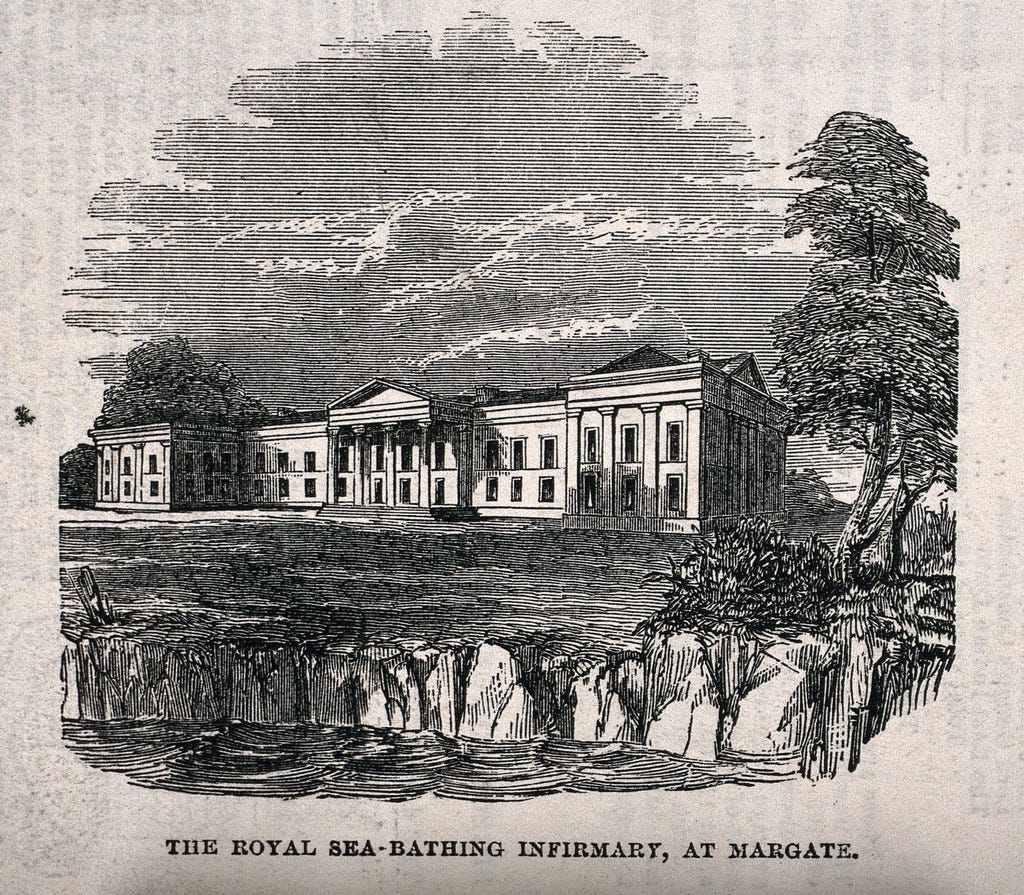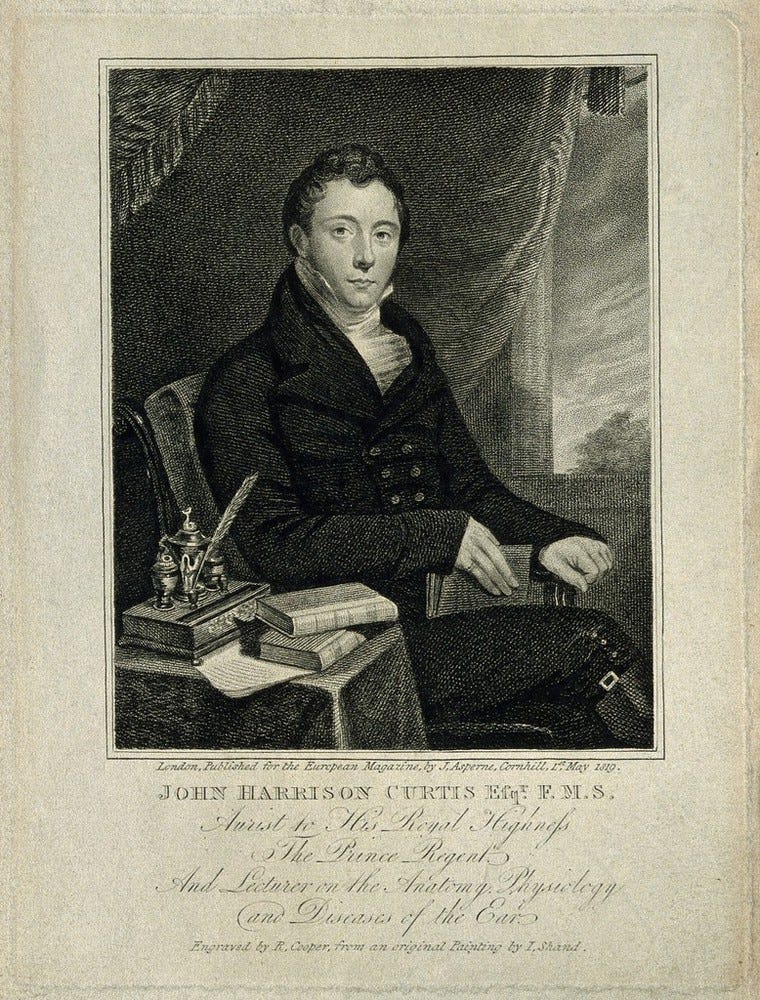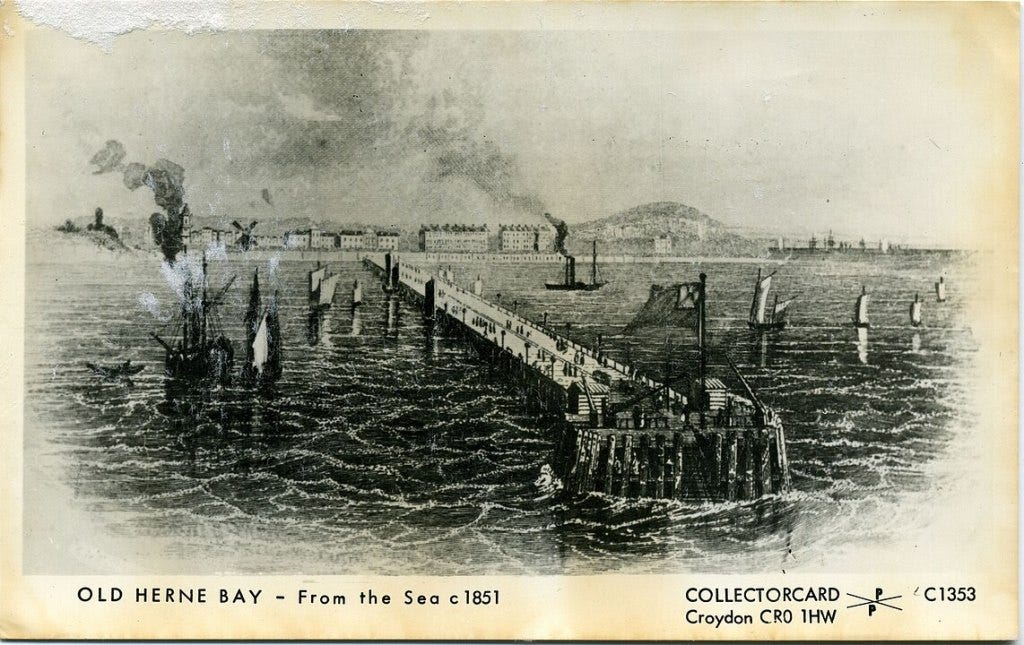The Chauncy family lived at Worcester for one year and nine months where Philip completed his education. They then moved to Ipswich in Suffolk. Philip, aged about 16, paid a visit to, John Harrison Curtis, his step-uncle (brother of his stepmother Anne Chauncy nee Curtis) in London and was it was planned that he would be trained by him as an ear doctor. Philip, however, became ill and this did not happen.
Philip was sent to Margate in Kent, where he became a patient of Dr Price, a notable physician. Philip described his illness as abscesses mainly on the neck but also on other parts of the body. Dr Price treated patients at the National Hospital for Scrofula (or Royal Sea-Bathing Infirmary). It seems likely that Philip had scrofula (mycobacterial cervical lymphadenitis), tuberculosis of the neck lymph nodes.

Scrofula was called the King’s Evil because it was believed to be curable by the touch of the sovereign, through the annointed monarch’s divine power to heal. Happily for this theory, scrofula often went into remission spontaneously, proof of the efficacy of the king or queen’s physical contact. William III is said to have remarked to a group of sufferers, “God give you better health and more sense.”
The cause of scrofula was not known until the late 19th century. The illness caused chills, sweats, and fevers. Due to the swelling of the lymph nodes and bones, skin infections and ulcerated sores appeared on the neck, head, and face. The sores grew slowly, sometimes remaining for months or years.

Scrofula is now treated successfully with antibiotics. Untreated it can develop into pulmonary tuberculosis, often fatal.
Fortunately Philip recovered.
The family removed from Worcester & arrived at Ipswich on the 30th March 1832, my Father having preceded them.
I had gone to London on a visit to my step uncle John Harrison Curtis, the Aurist of No. 2 Soho square who, having no Children of his own desired to bring me up to his profession.

He kindly took me about to most of the places worth seeing in London – to the Fête Champêtre in the Regent’s Park and to another at Cremorne gardens, both in the aid of the fund of the Royal dispensary for diseases of the Ear of which he was surgeon Aurist; and to many other places. I enjoyed the hospitality & kindness of himself and Mrs. Curtis for a month.
The proposal that I should learn his profession and succeed to his practice was overruled by an allwise providence:- I became ill with abcesses in the neck &c. And my Father sent me to Margate for change of air.

I took lodgings at Rankhorn near Margate and was placed under the treatment of Dr Price. I remained there about a year during which time I suffered exceedingly. The large quantity of matter I lost from a number of sores on the neck area, back, thigh &c. &c. greatly & permanently weakened my constitution. However I was often well enough to walk out and sometimes amused myself by shooting sea birds from the cliffs & by taking other outdoor exercise.
On one occasion I made a delightful excursion in the English Channel with some fishermen dredging for oysters – we remained at sea in an open boat all night.
At another time my fellow lodger Mr. Sayer & I went in a lugger or fishing boat to witness the opening of the new pier with the statue of William IV at Herne Bay. There were at that time only two fishermen’s huts there – and in course of erection about thirty brick houses including two large hotels. Thus this pretty little bay suddenly sprang into a watering place of importance.

The day was fine and the scene exhilarating, hundreds of people having arrived to witness the ceremony & participate in the gaieties. The distance from Matagte is about 20 miles – the afternoon wore on & the boatmen delayed returning. At length I ascertained that as bad weather was coming on they did not intend going back until morning. Young Sayer started on foot twenty two miles along the beach, but I was too ill and weak to attempt walking. There was not a bed to be had and all the vehicles were overcrowded on their return to Canterbury & the other places whence they had come. After walking about in the rain until midnight I, at length found the men & one of them carried me on his shoulders through the shallow water to our little lugger, and I crept with them into the forecastle among the oysters, dredges, cables &c. We quite filled the place. I was drenched to the skin with rain and was doubled up with my face and knees nearly touching the deck above me, through the seams of which the rain poured in torrents. I was lying on lilliputian mountains and on trying to change my position found I was fairly stuck fast with the pitch and could not move. The men had been indulging in drinking and were all fast asleep. I shall never forget how I envied their sound and comfortable repose and how I longed to go to sleep or be able to move out of my cramped position. But my troubles had not reached their climax – the candle which had been stuck to the side of the boat had burnt down and was setting fire to the pitch, – I tried in vain to reach it to put it out. I then attempted to waken the men by calling, kicking & punching them as well as I could; nor was it until the fire had fairly ignited the boat that one of them extinguished it.
At daylight the wind had moderated and being fair we soon reached Margate. So ended what I have always looked back upon as a romantic if not a pleasant trip.
During my month’s visit at Mr. (afterwards Sir John) Curtis’s, his nephew Saml Curtis who had been articled to him was still in his surgery but contrary to his uncle’s wishes he purchased a commission in the Army. This led to a dispute which ended in a trial, on which I was subpoenaed as a witness from Ipswich on 1st Feb 1834. The trial came off on the 24th & I was examined by the well known barrister Mr. Phillips. After the trial I dined at the Guildhall Hotel with Mr. Curtis friends. While in London I visited the King’s College, Vauxhall & other places of note, but soon returned to Ipswich where my Father & the family then lived.
But to return to Margate – Under the able treatment of Dr Price I so far recovered in twelve months as to be able to return home to Ipswich, where I was formally admitted a member of the Independent Church of which Mr. Whitby was the minister.
How I came to be a surveyor
My Father had long desired to fix upon a suitable profession for me, and as Dr Price of Margate had expressed his opinion that I would never be fit for a sedentary life and had recommended the profession of a Land Surveyor for me …
Philip’s memoir continues with an account of his training as a surveyor. I will resume his story in a future post.
Related posts and further reading
1877 Memoir by Philip Chauncy
The unfortunate death of Goodman Hughes (From another branch of the family; Goodman Hughes died of scrofula)
S. Grzybowski, E.A. Allen, History and importance of scrofula, The Lancet, Volume 346, Issue 8988, 1995, Pages 1472-1474, https://www.sciencedirect.com/science/article/pii/S0140673695924787
Shuttle, A. (2023, February 28). Dr David Price – JMW Turner’s Physician. British Library: Untold lives blog. https://blogs.bl.uk/untoldlives/2023/02/dr-david-price-jmw-turners-physician.html
Richardson, H. (2021, December 4). Margate’s sea bathing hospital. Historic Hospitals. https://historic-hospitals.com/2017/12/27/margates-sea-bathing-hospital/
Virdi, J. (2010, May 13). Who is John Harrison Curtis (1778-1856)? From the Hands of Quacks. https://fromthehandsofquacks.com/2010/05/13/who-is-john-harrison-curtis-1778-1856/
Brown, D. (2015, August 2). John Harrison Curtis and his acoustical chair. English Historical Fiction Authors. https://englishhistoryauthors.blogspot.com/2015/08/john-harrison-curtis-and-his-acoustical.html
Wikitree:
Philip Lamothe Snell Chauncy (1816 – 1880)
John Harrison Curtis (1784 – 1852)
This post was first published at https://anneyoungau.wordpress.com/2025/01/24/philip-chauncys-memoirs-continued-recovering-from-scrofula-in-margate/

